-

BOOTS NEEDED: Literally Support a Climber

LITERALLY, SUPPORT our program climbers by providing boots…
Christmas is less than a week away!
You may be last minute shopping and running those last errands for your annual Christmas party; we are busy this week! When you’re out-and-about this week consider supporting our program in a practical way…
The most essential piece of gear for any physical activity often starts with the feet. Our feet are our base. We use our feet to walk, to shop, to run, to go get the mail, to meet a friend and for us, to climb. They are the “foundation” to our bodies framework (for most of us). When it comes to hiking and climbing, it starts with a good pair of boots!
Our program relies on donations and is in need of boots! Hiking boots and mountaineering boots; both!
Well supported, waterproof, hiking boots is what we are looking for. You can donate boots to us directly here (Donate Gear Here) or by visiting our REI “Climbing Out Wish List”. More specific details are provided there. (Climbing Out Wish List)
If you have questions, email us at info@recoverybp.org
No Boots? Other Items Needed at this time:
-Micro-Spikes
-Gaiters
-Hiking Pants
-Rain Pants
-Base Layers
Visit Here for more specifics: REI Wish List
0 -

NOT Going Home – Homelessness Shows No Signs of Going Away
Image courtesy of The Gospel Herold.
On November 17th right before Thanksgiving, the Puget Sound Business Journal published a set of articles about recent reports about Homelessness in the Seattle area. There were several take aways:
- Homelessness is growing; the causes and issues are complex, and few solutions have worked.
- The government agencies that are accountable for addressing the issues caused by homelessness do not work together coordinating programs, services or budgets. A result is a silo approach which provides a variety of opportunities for people to fall through the cracks; unable to get the help they need to get off the streets.
- Often homelessness is a byproduct of the rapid rise in rents and the low number of affordable housing units available; job loss or a medical issue; with single-parent families being among the hardest hit and with the fewest options for shelter and support.
- The homeless population is straining the city and county budgets and resources at current levels; the growing numbers have decision makers very concerned about the near future. There isn’t a concise method of even reporting all the costs involved with the impacts of homeless individuals. Current measurement methods do not capture the cost causers across organizations and agencies. One article highlights the $746 million spent on a “disjointed patchwork” of programs; which include money donated to non-profits that deal with part of the problem. No one group provides services for all levels of need. See “Levels” chart below.
- The report also calls out the myths surrounding homelessness. The Seattle Report cited the following examples:
- 90{637c4c527fde39f83a380e19107d2ba88ad72607f37ccf8f8b7edeff1c20688c} – Of homeless individuals said they would move into affordable housing if available.
- 41{637c4c527fde39f83a380e19107d2ba88ad72607f37ccf8f8b7edeff1c20688c} – Of homeless individuals said they were working full or part-time with some employed in temporary and seasonal positions.
- 30{637c4c527fde39f83a380e19107d2ba88ad72607f37ccf8f8b7edeff1c20688c} – Of homeless individuals noted that job loss was the primary reason they were on the street.
- 70{637c4c527fde39f83a380e19107d2ba88ad72607f37ccf8f8b7edeff1c20688c} – Of homeless individuals said that they could only afford $500/month for rent.
- 258 – The number of people added to the homeless population each time rents increased 5{637c4c527fde39f83a380e19107d2ba88ad72607f37ccf8f8b7edeff1c20688c}.
- Homelessness is rooted in shortcomings of other systems, such as foster care, incarceration policies, mental health practices and general drug and alcohol addiction crises. A general lack of mental health providers and case managers were also cited.

Annual Homelessness Count
Each year a count is taken to determine the homeless population in the Seattle, King County area, please see chart below for the last seven years. The previous four years have seen dramatic growth across the region. One report showed the about 40{637c4c527fde39f83a380e19107d2ba88ad72607f37ccf8f8b7edeff1c20688c} of our homeless population are not originally from the Seattle – Tacoma area.

On the east side, the number of homeless families has grown tragically. There are no homeless shelters which cater to families with young children currently on the east side. A new family day shelter opened about a year ago. If money can be raised and property found, the hope is that this shelter would expand to offer year-round full time living options. By using a coordinated approach, over 40 families have found transitional or permanent housing and have moved off the streets.
Seattle’s new Mayor Jenny Durkin is quoted as saying “We are this prosperous city in the most prosperous country of the world and yet we have thousands of people sleeping in tents and doorways. We need to do better”. We believe we can do better.
Community Impacts
Homelessness is a community problem, systemic inefficiencies, the opioid crisis, and the increased number of deaths due to overdosing impacts everyone. Violent crimes are up; homeless people get sick more often and burden the healthcare system. The cost to treat someone from the streets is four times higher than someone with a home. Other data provided additional grim realities:
- Estimates show that 12,000 homeless people live in King County’s six sanctioned encampments. There are 400 other unsanctioned encampments, many living in cars or in overnight shelters.
- $1.06 billion is spent annually in Puget Sound to respond to homelessness and its issues.
- The estimated cost of house and care for our homeless would be $192 million a year.
- None of the costs mention includes those incurred by the Seattle Police Department or Harborview. Public agencies don’t uniformly track costs; so it is difficult to see the whole picture.
- There is no system to identify the homeless; so they may end up being recycled through the medical system and jails without ever getting them the help they need, for example, mental health prescriptions or addiction treatment. Washington State ranks 47th in the nation for access to mental health services according to Mental Health America.
- The US Department of Housing has not allocated a penny for public housing since 1996. Future budgets are not hopeful either.
Solutions
The only real sustainable solution is prevention. By preventing people from falling through the systemic support cracks, we could prevent homelessness in the future. But first, there is still a lot to learn about the causes and issues around why people end up on the streets right now. This problem is an individual one; each person comes with their own story. Each story has implications for a different set of circumstances, root causes. A plethora of possible changes would be necessary to address these outcomes and alter their results. One approach is developing services, providing case management resources and additional funding safety nets to help vulnerable people and their families. It also means being ready to tackle upstream problems. There is little doubt that it would be cheaper and less traumatic if we could stop homelessness from ever occurring; rather than treating it as we are today.
Addiction may be the most important root cause today, especially with the growing opioid problems across the country. Possible solutions would need to include:
- Additional treatment centers and increased number of beds for those ready to enter treatment. Until the individual is prepared to address the causes of their addiction, their behavior won’t change.
- The small number of affordable or low rent housing units and rapidly rising rents mean that more people with little or no earning power are at risk. This is especially true for those with disabilities or limited capacity.
- Often transitional housing is the first step toward re-entering society; job training, counseling, medical services are all part of the safety net to keep people off the streets. Social services that offer case management support are the quickest way to assure all the issues are being identified and an action plan developed and monitored to alleviate problems and keep them from repeating.
- Some large and small employers are beginning to work together to supply part of the missing services. This is a sign of hope. It also allows them to find valuable future employees once underlying issues have been addressed and job training or needed skills are gained.
Why do we care? We see the spectrum of need and fill a small role in assisting people in their recovery process by offering physical fitness, companionship, and mentoring to develop the socialization skills necessary to be part of the team and to learn to set goals, helping our recovery participants to succeed. By working with mission partners, we augment the treatment program they offer. We’ve measured our results over the last three years and have seen an 85{637c4c527fde39f83a380e19107d2ba88ad72607f37ccf8f8b7edeff1c20688c} sobriety rate. We believe that after seven years, we are ready to help more people in our community to find the healing and peace they need. Our community will be better off as a result of a more coordinated individual approach and by building the safety net many need. We aren’t giving a hand out; we’re helping by providing a hand up. Please consider how you can help. After all, we are in this together.
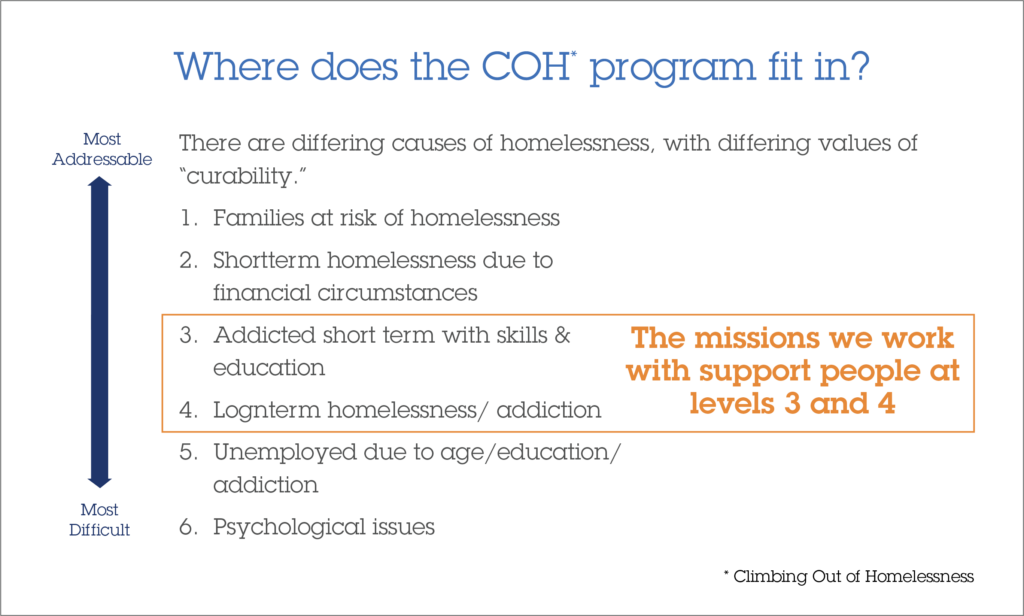
The Truth About Homelessness (Infographic)

-

Make An Impact This #GivingTuesday
Helen Keller said – “Alone we can do so little; together we can do so much”
We do have so much to be grateful for. #Giving Tuesday is a follow-up to the mass purchasing behavior we exhibit on Black Friday and Cyber Monday. Its purpose is to focus our attention on deserving non-profits who do so much to help our community; more than we know or can calculate. It’s a two-way street, we support them and they provide an outlet for issues we are passionate about, but may not have the time to get actively involved with. Regardless of your reasons, supporting these groups provides for needs that otherwise would go unmet. People depend on non-profits to fill the gap left where social services offered by our government agencies leave off. These same non-profits depend on public donations to keep their doors open and welcome those in dire straits.
This year we are proud to be part of that group of non-profits providing a lifeline to those trying to escape the pull of addiction; people who don’t have anywhere else to turn. Like other non-profits, we can’t survive without the generosity of people of good will. People who know that by becoming a more caring community we can do tremendous things.
Why is giving a good thing? The heart is a muscle that needs to be exercised to be healthy and working up to capacity. Our ability to give is one measure of how well our heart (and conscious) is working. There have been many studies touting the benefits of giving and volunteering time; apart from the physical and emotional benefits, the connections we make are very rewarding for those we serve. These social connections are very good for us, too. They keep us engaged and learning; while providing support for others, they help us gain or strengthen skills. During the holiday season, it’s good to assess where we are giving and where we could be giving more of our treasure or our time. It is ‘with and through community’ that we can make the largest impact; where we can share the wisdom we have gained and offer consolation for those who are working to regain control of their lives.
Please consider the many ways you can become part of our Community of Compassion. Compassion is defined as sympathetic consciousness of others’ distress together with a desire to alleviate it. Recovery Beyond’s goal through our Community of Compassion members is to make homelessness due to alcohol or drug addiction a thing of the past. We assist with a therapeutic approach to sustained recovery and reentry into society during our 10-month program. Please find joy in giving to the non-profits of your choice. Our Climbing Out Program is one place that will make good use of your donations.
Learn more about what we do at Recoverybp.org to get involved or to get help.
Winston Churchill once said, “We make a living by what we get. We make a life by what we give.”
-

Becky Vinson
She is on our team.
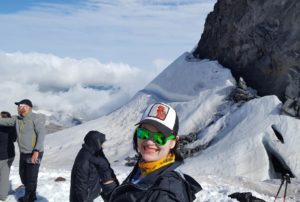
Becky Vinson is known for her deep love of others and an “I-can-do-that” attitude. This last year, she was one of our community climbers with our Climbing Out program. Her wit, sass, and southern charm is top-notch in our book. Becky is one of a kind. Recently we had the opportunity to interview her and hear more about what makes Becky, Becky. She shared her ups and downs, the courage needed along the way and some of her reflections on the climbing program.
We are glad to know her. She is on our team.
Becky lived through more real-life nightmares than most kids ever should. One of her earlier memories was losing her father. He was murdered at a local pool hall after a fight broke out. Her family was devastated and she felt horrified that she never was able to say “goodbye”. Things got worse. Home life was hell. With a very abusive step-father at home, home was not “home” at all. During Becky’s senior year in high school she was kicked out of her house. She was homeless and just looking to catch a break.
Growing up on a hog farm in North Carolina teaches a kid a thing or two about hard work. She possessed some deep seeded grit and toughness, or at least enough to keep moving. Becky knew she had to do something more than stay homeless and one day, she finally caught her break.
There was a posting for a military test in town and if you showed up you would get donuts. She thought, “I don’t think the military is for me, but I’ll go for the donuts and take the test.” She ate donuts, and to her surprise, she aced the test. “Every branch of the military was calling,” said Becky. The first shimmer of light was breaking through. She thought, “this will get me off the streets. They have food. I will get education and money. I have to do this.”
“Every branch of the military was calling.” The first shimmer of light was breaking through. She thought, “this will get me off the streets.”
A few months later she was at boot camp facing another challenge; one that became a defining moment in her story.
“I’ll never forget this as long as I live. During one of our trainings, I really wanted to take a breather; I couldn’t keep going. They don’t let you do that there. The drill sergeant was yelling at me and I told him ‘I can’t do it’! I think he saw I was actually trying and I was serious. The sergeant broke out of character a bit and said, ‘Listen if you put your mind to it, you can do it’. That’s pretty much all I needed. Thank God, he said that! That changed my mind set forever. I already was doing this, but it sunk in deep then. And it’s changed me forever. It’s now the attitude I always hold.”
After the military Becky continued to beat the odds. She aced most of the ACT and decided to become a nurse. “I could then finally legit go to college; I knew I was smart. No one in my family went to college. When I was young I was told I was dumb and I trusted that. It was totally false. To come from being homeless to going to college; this is still my greatest personal achievement to date. I was so happy to be there! I was like ‘EDUCATE ME, I’M ALL IN!'”
“‘Listen if you put your mind to it, you can do it’. That’s pretty much all I needed.”
This narrative of overcoming impossible challenges continued on and on. As a senior in college she adopted a 14-year-old kid from a church she was attending. He went on to play in the NFL. She traveled to other countries to help with their medical practice. She knew that administering medicine was needed in those desperate lands, so she went back to school and became a nurse practitioner.

This past year we journeyed with Becky’s and her story as she joined our Climbing Out climbing team.
She wanted to face another challenge; the “impossible” goal of climbing Mt. Rainier. And also to do it with what she calls “MY PEOPLE”. “If they can do it, I can do it, and vice versa. This is just another obstacle and I am not afraid.” Becky’s vibrant personality became a gift for the entire team. And more importantly, Becky, like the rest of the obstacles in her life, continued to show up with the attitude of “If you put your mind to it, you can do it.” On a fitness level, she was a long shot to be ready and able to climb. But by the summer, Becky had “wow-ed” us. She trained and trained and trained. She was ready. And she climbed mountains.
Some significantly challenging moments earlier in life made Becky the woman she is today. Taught her she is stronger than she thinks she is, and wth a team you can go far in life. Becky, you are a dangerously-brave, fun-hearted mountain climber my friend.
“This is one of the most life-changing volunteer experiences I’ve ever had.”
When asked “what would you say to others considering volunteering?” Becky’s replied by saying: “You’d be a fool not to do it. I am a person that does enormous amounts of volunteer work everywhere I’ve been. This is one of the most life-changing volunteer experiences I’ve ever had. Try it out!”
Becky’s story inspires us. She is on our team.
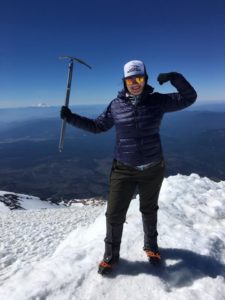
-

Our First Movie Night
Our first movie night was held on September 17th at Mary, Queen of Peace Church in Sammamish, Washington. This event kicks off our fundraising cycle for the next program year which begins in October.
We had the opportunity to tell the Climbing Out story to people who were very interested in helping those struggling with permanent housing and the reasons for it. Addictions of all types drag people down. Addiction destroys self-esteem, relationships and families, and causes a host of physical, emotional and mental problems. The Climbing Out program offered by Recovery Beyond offers a holistic approach to the needs of each individual. This approach addresses the priorities in the next stage of treatment and recovery. Working with our partner missions, we can accomplish more in the year or two when we join together in working with clients.
Our volunteers and mentors walk the journey with our clients as friends and a source of wisdom, experience, and support. These relationships are a very significant part of achieving long-lasting results. We can’t thank our volunteers enough for the love and care they provide.
While we are still developing a full set of metrics to track progress and overall success, we know that the Climbing Out program works because our clients are the proof. Not only do they complete their treatment program, but many come back joining next year’s program as a volunteer and mentor; supporting others through the perilous journey to sobriety. This Community of Compassion is what you join when you support us with your ongoing gift of time, treasure or equipment.
Some of the program participants attended this event; sharing their story and the impact the program had in their lives. We hope that this message of hope shared through personal stories in the film will foster increased giving offering grow the programs Recovery Beyond sponsors.
Make A Donation Today! -

Mountains help us out…
“In every walk with nature one receives far more than he seeks” ~ John Muir

Ascent Up Mt. Rainier
This year was different than most climbing years. It presented new challenges and more “failure” than I expected or knew how to handle.
How will I respond to failure? How will I choose to tell the story?
There’s this mantra out there, maybe it’s on a bumper sticker somewhere or maybe it’s called the American Dream, that if you work hard enough you will get what you want. When I was a kid I remember my parents telling me I can become whatever I want to be, as long as I put my mind to it. I think I asked my mom if I could work at Disneyland when I grow up. I’ve obviously missed my calling. But that’s how life works right? You can get what you want by the power of your will.
Or is it?
Mountains help us out.
I appreciate that about mountains. They are realistic. They don’t apologize. They don’t care about my feelings. They are indifferent to my life goals or my 7-step plan. Sometimes a mountain lets you climb, and other times it doesn’t. Somehow being at the mercy of a mountain sets my perspective just right.
Reality … check.

Camp Muir, Mt. Rainier
If you take a look back at an earlier blog post from this year, you’ll read a story about a serious mountain “gut-check”. Back in May we went after Mount Hood and we pretty much failed. It was tough. The mountain was not kind. We weren’t prepared and we got whipped, with about half of the team turning around early. Our team felt scattered and could have fallen apart. It was hard. But it became both a teacher and a motivator.
We trained harder, we got faster, stronger, and more connected as a team. “This time we will be ready!” Some climbed extra mountains to prepare. Diets became more strict. Technical training increased. Mount Rainier was in our sites and we were going to get it this time. This time will be different.
Mountains help us out.
Mount Rainier said no. Mic drop. At 13,500 ft, a snow-plug the size of a football field fell through making the route impassable. The mountain decided it wasn’t going to let us climb. No one climbed to the summit for three or four days, us included.
Reality… check.
We say this phrase a lot, I’m sure you’ve heard something similar a time or two…“life is about the journey and not the summit”. WHAT. Get out of here. I want the summit! I’ll be honest with you, I want to get to the summit and then get the heck off the mountain. Another notch on my belt. (Maybe I should work at Disneyland; where dreams do come true.)
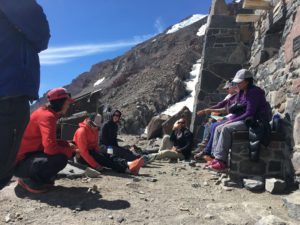
Team Debrief of the Rainier Climb
This year the metaphorical mountains we had to cross and trek over as a team were more technical and demanding than years in the past. This required more out of us every step of the way. More teamwork, more communication, more strategy, more change of plans, more love, more humility, more of us in every way. In the moment it sucked, but looking back, I wouldn’t want it any other way. This journey made us a team, and made each of us better women and men because of it. This team became accustomed to the value and worth of the team itself. In the end that’s what life’s all about anyway, who you take along on these messy, beautiful, life-adventures. This is the kind of life I want to live; living in the tension of the journey, with the risk of failure or success up in the air, doing it alongside those I love. These are the kind of stories I want to tell. The epic tales of a team.

Lounging on the newest mountain accessory. The inflatable couch.
I think it was best said by Matthew and Uncle Mark the evening before we set foot up the mountain back in August. Below, read what Matthew had learned. He nailed it; Relationship, failures included.
Sometimes we need failure like we need air. Sometimes a change of perspective isn’t what we planned on, but exactly what we need; reminding us about how to be human again and drawing us back together.
Mountains, help us out.

Matthew and Mark share their reflections
“I went from having no relationships, to having so many people surrounding me that love me. It’s really been those relationships that have gotten me to this point. If it wasn’t for my team and leaders, I would have never grown physically or spiritually as I have.
Im at the point now where I know that it’s not just about summiting; whether I made it or not. This (points at people around the table) is the victory that I have been seeking and searching for. Obviously that (the summit) is something I have been working for and is something I want, but it’s been the relationships that are the most important thing in life I’ve realized. You all are going to be here after Mount Rainier is over. So thank you.”
~ Matthew Arthur, 2017 Climber
“THIS IS THE PROGRAM. What we have here as a team, who you are now sitting at this table, that’s who you are, that’s what you’ve gotten from this program”
~ Mark Ursino, RBP President
-

There’s A Reason It’s Called “Climbing” And Not “Summiting”
For the first time in the 7 years we’ve run the Climbing Out Of Homelessness Program, Mt. Rainier got stingy and denied us (and everyone else climbing that night) the summit.
We met in Ashford on Saturday, August 12th for final gear check, and to get whatever gear the team lacked, courtesy of Rainier Mountaineering, who has opened their rental counter to us at no charge since the beginning.
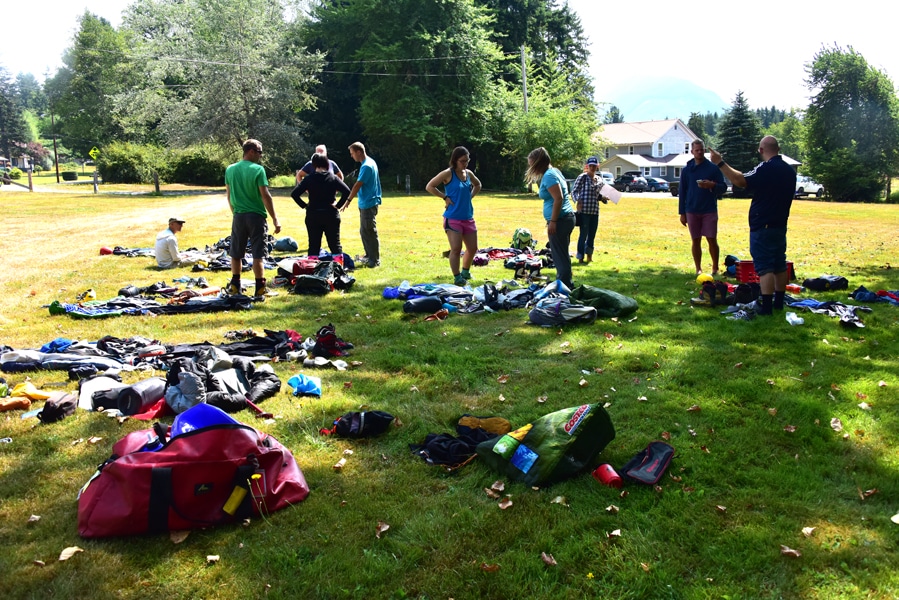
Gear Check Before Climb
At our annual pre-climb dinner at the Wild Berry Restaurant in Ashford, we caught wind of a huge collapse on the upper mountain on Rainier. We didn’t know what to make of it, but it didn’t sound good. The more we heard, the worse it sounded. It didn’t dampen our festival mood at the dinner, though, and we had our usual presentation of engraved ice axes to our Program Climbers.
We also had our annual “Sundae” and “Cherry” conversation. That is to say, the climbers have already had the sundae – the program and sense of team and accomplishment getting through the training, climbing Mt. Hood, spending the night on Mt. Rainier during our final climb simulation – this is your 3 scoops of ice cream. The summit is the much desired cherry on top, but whether they get that final reward or not, they’ve gotten the sundae.

Mike presents an axe to Matthew at the pre-climb dinner.
We woke on Sunday to a persistent mist and a very soggy mountain.
Camp Muir was just at the top of the clouds, though, so we were dry, and pretty much in the clear as we set up camp.
I met with Jason, one of our volunteer guides, and the person responsible for coordinating the efforts of the 3 guide services who are licensed to guide the Disappointment Cleaver route on Mt. Rainier, as well as commissioned with maintenance of the route. He told me that they had no idea if or when they might find a route past the trouble to the summit. He also let me know that he and Phil (another of our volunteer guides) would most likely be tied up working on the route, and wouldn’t be able to help us with the climb. I told him that I’d already figured that would be the case, and was working out contingency plans – none of which could result in all of us making a summit attempt.
We had dinner, and went to bed, knowing only that in the morning, the team would be going through another round of “Basic Snow School”, this time with Leon (our climb leader for the past several years) and Lindsay (who has been a key volunteer guide since 2013 as well).
Monday morning, the team got up, breakfasted, and hit the snowfield for their training with Leon and Lindsay. Meanwhile, when asking Jason about the situation on the mountain, he said that it could be summed up in two words, “Totally @#${637c4c527fde39f83a380e19107d2ba88ad72607f37ccf8f8b7edeff1c20688c}ed”.
“Meanwhile, when asking Jason about the situation on the mountain, he said that it could be summed up in two words, ‘Totally @#${637c4c527fde39f83a380e19107d2ba88ad72607f37ccf8f8b7edeff1c20688c}ed’.”
Since it didn’t look like there was going to be a route to the summit, Leon and Lindsay came up with a plan to take the team to Ingraham Flats (the first stop up from Camp Muir) the next morning as a way to allow them to experience and see more of the mountain, and perhaps lowering them into a crevasse just for giggles. It’s actually a pretty cool experience.
The team was disappointed at not getting a shot at the summit, some VERY disappointed, even though they had been prepared for the possibility. But the mountain rules.
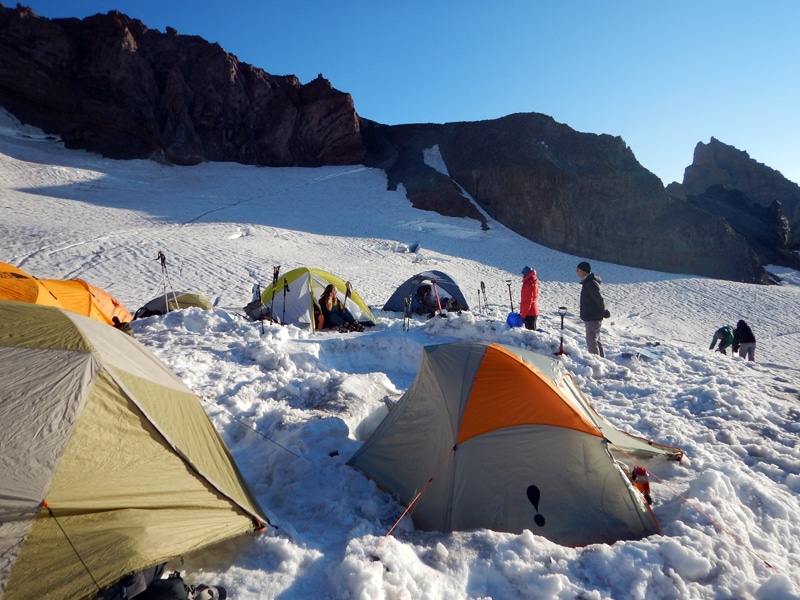
Our Camp At Muir
Just before the team went to bed, we received word that two professional guides had made it to the summit. That didn’t mean that there was a route that your average climber (much less a pack of newbies) could climb successfully, but it did mean there was some kind of a shot – maybe. So the team went to bed knowing there was a SMALL chance they might get awakened at 11 pm to climb, but most likely they’d get woken up later in the morning to climb to the Flats.
After the team went to bed, more guides headed up the mountain to try to at least heavily mark the route. Leon told us to keep our radios on, and he and Lindsay would make the call on the climb “later.”
Just before 11 pm, we got the call from Leon that he didn’t have any news from higher on the mountain, but he thought the Program Team should give it a shot. We rousted the climbers, had breakfast, got everyone geared up, and sent them out.

The climb team on Ingraham Glacier.
Even before the snow plug collapse, the route had been unusually long, hitting the summit in a spot no one (even long-time mountain guides) ever remembered it going. After the collapse, it was not only long, but hit a spot of mountain that was deeply sun-cupped into formations that are called “penitents” because the formations kind of look like people on their knees in prayer – thousands and thousands of people. They are very difficult to traverse, because there is no flat footing (at any angle), and you climb over and through the sun cups. There is no efficient way to climb, and the going is VERY slow.
The RMI guided group ahead of our group turned around just above 13,000’. Our team followed suit. The final push to the summit was going to take more than 2 hours, and being already over 5 hours into the climb, there was concern about people having the ‘gas’ to get down safely. Remember, the goal isn’t to get to the top, it’s to get back to the bottom – via the top if possible, but the top is optional, the bottom is not.
Everyone came off of the climb MUCH happier that they at least had taken a shot at the summit, and having gone through what they’d gone through, and seeing what they saw, knew that they had given it their best shot, and the mountain just wasn’t giving it up. No one summited that night, and I don’t believe anyone summited the next night either.
“Many of us throughout life need lessons in how to deal with disappointment constructively. And I think this team did.”
Not reaching the summit was disappointing for all of us, but the climb was a success. In some ways, maybe even a bigger success for NOT having summited. Many of us throughout life need lessons in how to deal with disappointment constructively. And I think this team did.
-
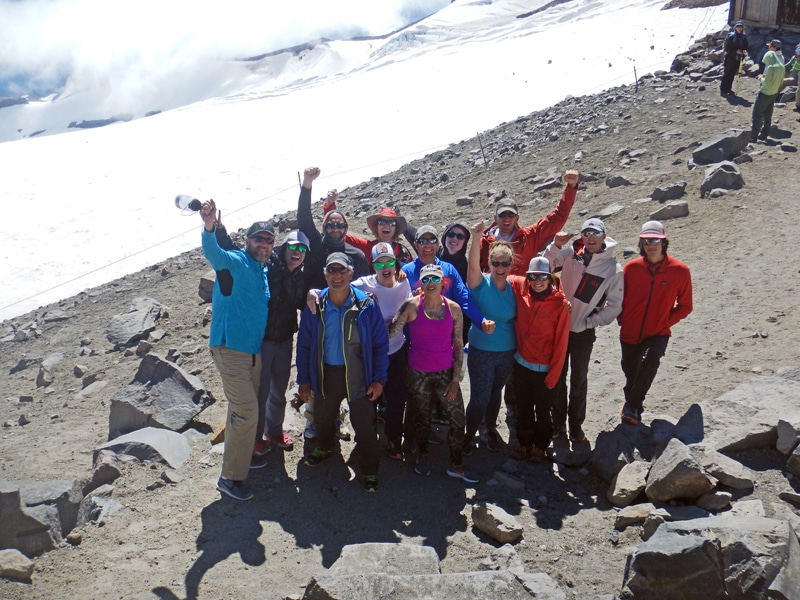
Our Relationships Are Our Summit
After our first year, we interviewed our recovery climbers. Every one of them said that the team experience was more meaningful to them than the summit itself. So we re-focused the program to emphasize team building and healthy relationships. We added community climbers alongside those climbing out of homelessness.
This year was the first year we had no effective route to the summit, and the emphasis on team-building paid huge dividends. We may not have been able to reach the mountain’s highest point, but the relationships were a true “high point” for all involved…and more enduring!
Life really is about relationships, and so is climbing. Our senior guide and friend Leon Davis was asked by one of our recovery climbers which mountain was his favorite to climb. He said, “I don’t think I have a favorite mountain, but I have had some favorite outings. Those really were about who I was with.” That’s what we got this year, Leon: and it really is the true summit.
-

Going Home – Seattle’s Union Gospel Mission
They say ‘you can never go home’, but that’s exactly what we are doing. This fall the Climbing Out of Homelessness Program will return to Seattle’s Union Gospel Mission. Our partnership with UGM began in 2011, based on a need to enhance the addiction recovery program. Taking a crazy idea that shakes up the perception of people by endeavoring to climb a mountain. Little did we know at the time, what a great metaphor that would become, both figuratively and literally. This isn’t just another physical fitness program; it’s a community way of helping our neighbors overcome the challenges of all types of addiction. Help us celebrate this homecoming by making a tax deductible donation today.
-

Join our Community of Compassion
Consider joining our Community of Compassion. By making an ongoing monthly donation of $20, you can give a new way of life for our program climbers. There are many ways to give, please see other suggestions on our website at https://recoverybp.org/how-you-can-help/
Changing the face of homelessness is really up to us. We support climbers in a number of ways. You may already be supporting one of the missions doing great work to alleviate addiction and its consequences. Our Climbing Out of Homelessness program helps make long lasting change possible. A community of compassion and support makes all the difference for the success of recovery. None of us achieve anything significant without the support of community. Our community is the key to this wonderful transformation.
Archive for 2017
Recovery Beyond > 2017
